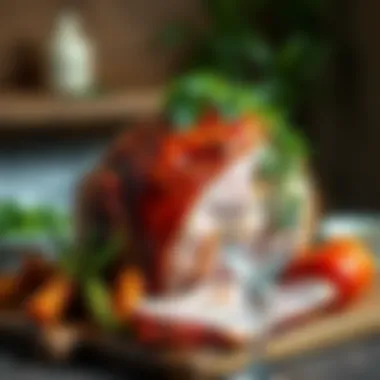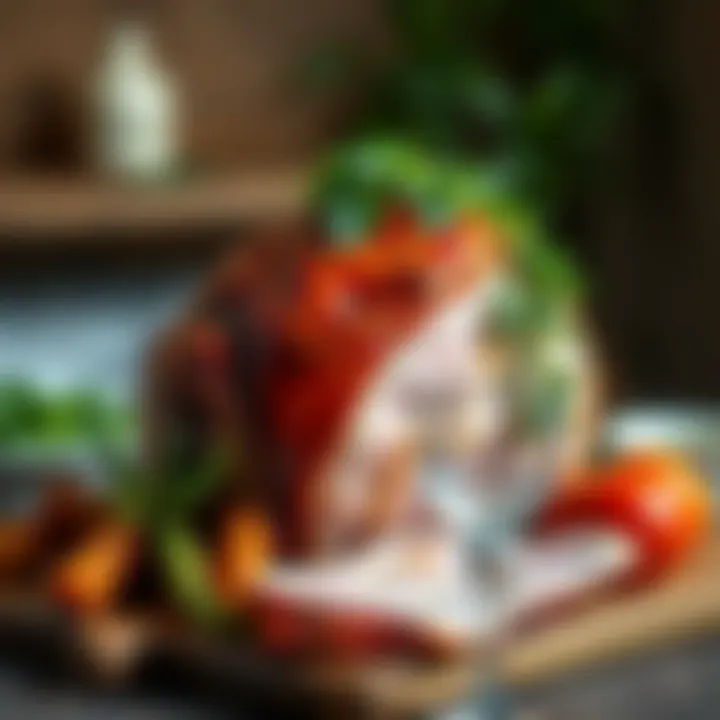Crafting the Ideal Easter Carry Out Menu


Intro
Crafting a memorable menu isn’t just about throwing together some dishes. It’s an intricate dance between tradition and modern convenience. From finger-licking appetizers to satisfying main courses, delightful side dishes, and sweet desserts, each element plays a crucial role in forming a cohesive dining experience. In this guide, you’ll discover how to strike the right balance while considering various factors like dietary preferences and presentation.
By the time you’re done reading, you’ll have a solid understanding of how to construct an Easter menu that not only impresses but also caters to diverse tastes. Let’s get rolling!
Understanding the Essence of an Easter Menu
Easter is a season steeped in richly woven traditions and customs that beckon us not only to celebrate but to come together around the dining table. An Easter menu embodies the spirit of the holiday: renewal, hope, and togetherness. The dishes we choose reflect not just our tastes but also our cultural heritage, stories, and the memories that bubble to the surface each spring.
Historical Significance of Easter Meals
The roots of Easter meals stretch deep into history, tracing back over centuries. Originally, these meals were filled with symbolic foods, perhaps not unlike the feast you may have had as a child. For many, lamb is the centerpiece, harking back to ancient sacrifice. In Christianity, it represents the ultimate sacrifice, and equally, the rebirth and resurrection that Easter signifies.
Moreover, foods such as eggs—painted and shared—represent fertility and new life. These traditions vary around the world, yet they all circle back to a common theme: rebirth and renewal. Historically, many cultures combined seasonal ingredients, like spring herbs and vegetables, with preserved foods. This is a fascinating glimpse into how our ancestors ate: seasons dictated what was on the table.
Let’s not forget about the sweet treat each Easter brings, whether it’s hot cross buns in the UK or sweet breads in Mediterranean countries. Each dish carries a narrative, engages the senses, and contributes to an enduring legacy of family gatherings that celebrate life anew.
"The share of a meal reveals the values we embrace. It’s not just about food; it’s about the togetherness it brings."
Creating a Modern Twist on Traditions
While historical significance is key, modern sensibilities invite a fresh perspective on the traditional Easter menu. The younger generation leans heavily into fusion cuisine, merging longstanding recipes with contemporary tastes. Imagine rosemary-infused lamb accompanied by a spicy sprout salad that adds zing to the plate.
Some people sway towards plant-based options, flipping traditions on their head to cater to vegan or vegetarian diets. Think stuffed bell peppers with quinoa and herbs or a vibrant asparagus tart that screams spring. This modern adaptation ensures that dietary needs are respected while still clinging to those beloved traditions.
The presentation also plays a crucial role in reframing what an Easter meal looks like today. Beautifully arranged charcuterie boards piled high with cheeses, fruits, and artisan breads create an inviting atmosphere that melds rustic charm with modern elegance. It’s about keeping the essence alive while embracing change.
Ultimately, the perfect Easter carry out menu should be a bridge between the old and the new. It tells a story filled with heritage but allows room for creativity, ensuring everyone at the table finds something that resonates with them.
In this way, every Easter meal becomes more than just another holiday dinner; it transforms into a culinary experience that celebrates our past while looking to the future.
Key Components of an Easter Carry Out Menu
Creating the ideal Easter carry out menu requires a blend of flavors, textures, and traditions that cater to a varied audience. It’s not just about preparing food; it’s about bringing people together, creating memories, and delivering an experience that resonates during the festive season. An engaging menu consists of carefully selected appetizers, vibrant main courses, and delightful sides followed by sweet desserts, making each component crucial in laying the groundwork for a memorable celebration.
Appetizers: Setting the Tone
Seasonal Freshness
When discussing seasonal freshness, aim for ingredients that sparkle in their peak season, bursting with flavor and nutrition. Incorporating seasonal veggies and fruits not only highlights your commitment to quality but also enhances the dish's taste. For Easter, think spring peas, asparagus, or even radishes—simple yet sophisticated options that feel right for the season.
An unmistakable charm of seasonal freshness lies in its direct connection to how food feels on your taste buds. Fresh ingredients uplift a dish, creating a direct link to nature's bounty and a vivid culinary experience. The significant advantage of focusing on seasonal ingredients is their availability and, often, lower cost.
Catering to Palate Diversity
Catering to palate diversity means understanding that every guest has distinct tastes and preferences. This can be as wide-ranging as mild flavors for children or robust tastes for those with more adventurous palates. Think small plates with a variety of dips or a platter featuring cheeses from different regions.
The beauty of a diverse appetizer spread is that it promotes exploration. Each guest can nibble on what intrigues them most, fostering conversation and a relaxed atmosphere. One potential challenge? Balancing flavors and ensuring some dishes don’t overshadow others in taste intensity.
Main Courses: The Centerpiece of the Meal
Classic Choices
Classic choices represent traditional favorites that evoke nostalgia and a sense of comfort—a roast lamb is often a staple for Easter gatherings. This brings to the fore the importance of familiarity in a meal where family traditions reign supreme.
Traditional dishes not only provide a strong centerpiece for the meal but also help set a narrative. However, one must mind that they stay relevant—lifting the act of serving these classics with thoughtful cooking methods or locally sourced ingredients can make a world of difference.
Modern Interpretations
Modern interpretations breathe new life into age-old classics. Imagine a roasted lamb leg served with herbal chimichurri instead of traditional mint jelly, or a vegetarian shepherd’s pie that appeals to meat-eaters and herbivores alike. With these interpretations, one can create a dynamic flavor profile that respects tradition yet pushes culinary boundaries.
This approach ensures inclusivity; you have options for even the pickiest of eaters. The caveat? Sometimes tradition is what people crave at Easter, and not everyone appreciates an unexpected twist on their beloved favorites.


Side Dishes: Complementary Flavors
Vegetable Varieties
Vegetable varieties can transform a good meal into a great one, adding color and nutrition. Roasted vegetables, such as carrots, beets, or Brussels sprouts, tend to shine when drizzled with olive oil and sprinkled with coarse sea salt. They’re not just simple accompaniments; they’re the side dish that makes your plate pop.
Using diverse veggie options supports dietary needs and enriches the flavor landscape of the meal. The drawback? Overloading on the more complex flavors can sometimes compete with the main attraction.
Starch Selections
Starch selections frequently act as the filling backbone of the meal—think fluffy potatoes, creamy risottos, or fragrant rice pilafs. These components provide essential comfort, allowing diners to feel grounded in their Easter feast.
Allocating attention to starch choices offers versatility; they can be prepared in various ways to complement main courses while satisfying diverse palates. A potential downside: turning the focus overly toward carbs might lead to unintentional overindulgence.
Desserts: The Sweet Closure
Traditional Easter Sweets
Traditional Easter sweets like hot cross buns or rich fruit cakes evoke fond memories and joy. These treats resonate across generations, making them essential in an Easter menu. They bring a sense of nostalgia that beautifully wraps up the meal, tying back to historical customs.
They’re comforting and delightful, but it’s crucial to balance the sweetness and richness. A rich dessert might overshadow lighter options that could refresh diners post heavy dishes.
Contemporary Dessert Options
Contemporary dessert options throw a modern twist into the mix. Think of light pavlovas topped with seasonal fruits or vegan chocolate mousse as alternatives to heavier traditional sweets. Such options cater to current dietary trends, appealing to those seeking to be mindful of sugar intake or fulfilling dietary restrictions.
In sum, modern desserts can offer an innovative flair, but they might lack the historical essence that make traditional sweets special. Understanding this balance can greatly influence the success of the culinary experience you provide.
Ingredient Considerations
When it comes to crafting the perfect Easter carry out menu, the ingredients you choose play a pivotal role. Ingredient considerations go beyond mere functionality; they touch on the essence of flavor, presentation, and dietary needs. By carefully selecting quality ingredients, you not only elevate the overall meal but also ensure a memorable dining experience that resonates with your guests.
Seasonal Produce and Herbs
The freshness of seasonal produce cannot be overstated, especially during Easter when nature is in full bloom. Using seasonal fruits and vegetables allows you to tap into the vibrant flavors that spring has to offer. Think of asparagus, radishes, and peas that add a crunchy and fresh profile to your dishes.
Additionally, don't overlook the importance of herbs. Fresh thyme, rosemary, and chives can transform a dish from ordinary to extraordinary. Their aromatic qualities enhance flavors, making every bite feel like a celebration. Aim to incorporate a variety of herbs to cater to diverse tastes; this way, you provide options that appeal to everyone, from the discerning epicurean to the more casual diner.
"Fresh ingredients not only taste better but also amplify the aesthetic appeal of your Easter spread."
In selecting seasonal produce and herbs, you’re not just creating a menu; you’re telling a story about the time of year and the bounty it brings. Consider visiting local farmers' markets or engaging with community-supported agriculture (CSA) programs, as they often provide the freshest options.
Sourcing Quality Proteins
Proteins are the backbone of any meal, especially for Easter where traditional favorites often take center stage. Sourcing quality proteins is crucial, as it directly impacts the taste and healthfulness of your dishes. Whether it’s succulent lamb, tender beef, or free-range chicken, choosing organic and ethically produced meats can elevate the palate while supporting sustainable practices.
When selecting proteins, consider your audience. Some may have preferences for specific cuts, while others might lean towards plant-based options. Including grass-fed options or even local game can add a unique twist to your menu, while still being conscientious of the more traditional choices.
Balancing Flavors and Textures
The art of balancing flavors and textures is where culinary magic happens. A successful Easter carry out menu should be a symphony of tastes—sweet, savory, sour, and spicy. Think about how each dish interacts with the others. For example, a rich, creamy potato gratin pairs beautifully with a tangy citrus salad, creating a delightful contrast that keeps the palate engaged.
Similarly, texture plays a critical role. Including crunchy elements alongside creamier dishes adds dimension. Consider crispy roasted vegetables or a light, airy mousse among denser items like a hearty lasagna
In crafting your menu, aim for harmony. You want your guests to have a varied experience that takes them through a tapestry of flavors and textures, enticing them to savor each bite until they’ve reached a content closure with dessert.
Dietary Preferences and Restrictions
Understanding dietary preferences and restrictions is crucial when curating an Easter carry out menu. Today, many people pay close attention to what they consume due to health, ethical, or personal reasons. If you plan to host an Easter gathering, ensuring your menu caters to various dietary needs not only demonstrates thoughtfulness but also enhances the overall experience. A well-rounded menu can accommodate everyone, making the celebration more inclusive and enjoyable. To that end, there are key dietary considerations you should keep in mind.
Vegetarian and Vegan Options
In the culinary landscape, vegetarian and vegan dishes are no longer viewed as secondary or limited choices. Instead, they offer a bounty of flavors and textures that can rival traditional meat-based meals. As Easter often centers around springtime and renewal, incorporating dishes like roasted beet salad or a creamy vegan mushroom risotto can add bright, seasonal notes to the menu.


Further, consider flavorful appetizers such as stuffed mushrooms prepared with breadcrumbs and herbs, or a vibrant quinoa salad that bursts with seasonal vegetables. For main courses, dishes such as a plant-based shepherd’s pie or an eggplant parmesan can delight even the most committed carnivores. It's also essential to ensure that any sauces or dressings are vegan-friendly, as they can often contain hidden dairy or eggs.
Key Point: Curating delicious vegetarian and vegan options allows everyone at your gathering to participate and indulge in the feast.
Gluten-Free Dishes
Going gluten-free is a necessity for many people due to celiac disease or gluten sensitivity, but it should not limit the deliciousness of your Easter menu. In fact, gluten-free cooking can yield remarkably tasty dishes that still satisfy. Think outside the breadbox; for instance, a herb-infused potato salad or a hearty red quinoa and vegetable dish can serve as stand-ins for traditional grains.
When preparing a gluten-free menu, be cautious of cross-contamination, especially if you're using shared kitchen tools or surfaces. It's also wise to read labels on all packaged products, as gluten can lurk in surprising places such as sauces and dressings. A focused approach to gluten-free options can showcase items like crisped cauliflower steaks or gluten-free pasta tossed in a luscious and rich pesto.
All in all, gluten-free dishes can be as scrumptious as their gluten counterparts, given the right attention to detail and flavor layering.
Nut-Free and Other Allergen Considerations
With food allergies on the rise, making a note to avoid nuts and other common allergens can ensure a pleasant experience for all guests. While planning your Easter menu, be mindful of dishes that feature nuts, such as pesto or certain desserts, which could inadvertently exclude those with allergies.
Furthermore, many people are sensitive to other allergens such as dairy, soy, or shellfish. Reviewing a comprehensive list of potential allergens and highlighting your menu can be beneficial. Always have alternative food options available—such as dairy-free desserts made with coconut milk or creamy sauces made from cashew cream.
Additionally, labeling food items can help guests navigate the buffet-style spread with ease, so they can pick foods that align with their dietary needs without worry. This kind of transparency creates a relaxed atmosphere where everyone can enjoy the feast worry-free.
Ultimately, catering to dietary preferences and restrictions reflects a commitment to guests' wellbeing, making your Easter gathering not just about food but also about community and care.
Presentation and Packaging
When planning an Easter carry out menu, presentation and packaging play an essential role that goes beyond mere aesthetics. They serve as the first impressions your guests will have of the meal. Well-thought-out packaging not only preserves the quality of the food but also enhances the overall dining experience. Imagine a beautifully set table with vibrant colors and elegantly arranged dishes; it is visually enticing and makes the meal feel more special. Therefore, it is crucial to give due consideration to this aspect when curating the perfect Easter menu.
Importance of Aesthetic Appeal
Aesthetic appeal isn't just about making things look good; it's about invoking emotions and setting the mood for the occasion. Research shows that people often eat with their eyes first. When dishes are artfully presented, they spark curiosity and excitement, making your meal a feast in every sense of the word. For Easter, incorporating seasonal colors like pastel pinks, yellows, and greens can evoke the spirit of the holiday.
To enhance the aesthetic aspect:
- Use vibrant ingredients that naturally catch the eye, such as brightly colored bell peppers or fresh herbs.
- Incorporate different textures. A plate consisting of crunchy, smooth, and creamy items delights both the eyes and the palate.
- Consider the plateware. Unique plates or serving trays elevate the entire presentation, making down-to-earth dishes feel gourmet.
"Presentation is not just about how food looks; it’s about how it makes you feel before you even take a bite."
A thoughtful arrangement of food can engage everyone, from the littlest of children to the most discerning food critics. Grownups appreciate intricate designs, while kids may be more inclined towards fun shapes or playful displays. This careful balance of aesthetics can serve to make the meal memorable and foster a joyful atmosphere.
Effective Carry Out Packaging Techniques
Selecting the right packaging for an Easter carry out menu boils down to several practical considerations that intertwine functionality with style. Here are some techniques to ensure the food arrives looking as delightful as it tastes:
- Insulation is key: Use insulated containers for dishes that need to stay warm, like glazed ham or roast vegetables. This will help maintain the dish’s heat and flavors. Look into heavy-duty foil or thermal bags that hold the heat for longer.
- Separate components: For items like salads or dressings, insulated clamshells serve well. Keep dressings on the side to prevent sogginess; nobody wants a limp salad.
- Emphasize Eco-friendliness: Nowadays, sustainability is paramount. Using biodegradable containers speaks volumes about your caterer's commitment to the environment. Not only are they practical, but they also resonate well with eco-conscious customers.
- Labeling: Clear labels can be helpful, especially for dishes with allergens or special dietary considerations. A simple ‘gluten-free’ or ‘contains nuts’ can avoid a mixed bag of confusion.
The envelope of an Easter dinner should mirror the spirit of the festivity, providing both practicality and charm. Effective carry out packaging ensures your dishes arrive in prime condition and makes every guest feel special. By adding a touch of care, your Easter menu can transform from a simple meal into a celebratory experience.
Logistical Considerations for a Successful Carry Out Event
The main goal here is to harmonize the culinary experience with efficiency, serving not just appetizing food but also a seamless service that leaves everyone satisfied. By finessing the logistical side of things, you create a structure that anticipates needs, making the occasion memorable.
Timelines for Preparation and Execution
When it comes to pulling off a successful carry out event, time is of the essence. Here are several key phases to consider:
- Advance Planning: Ideally, everything should start two weeks ahead. This includes choosing the menu, sourcing ingredients, and finalizing orders. Waiting till the last minute can lead to increased stress and potential mishaps.
- Ingredient Sourcing: Allocate a week for procuring ingredients, focusing on seasonal produce and quality proteins. Early sourcing ensures you have everything on hand, avoiding those last-minute dashes to the store.
- Cooking Schedule: Dedicate the day before the event for the bulk of the cooking. This helps in managing the stress of the day while allowing for minor hiccups during cooking.
- Final Touches: The day of, spend a few hours focusing on plating and packaging the items for carry out. This way, dishes not just taste great, but look appealing too!
In short, having a well-thought-out timeline can transform chaotic preparation into a breezy experience.
Coordinating with Catering Services
When considering an Easter carry out menu, you might think going solo is the way to go. However, collaborating with catering services can bring a bounty of benefits:
- Expertise: They offer knowledge about popular dishes and contemporary trends, helping to elevate your menu while keeping a traditional undertone.
- Preparedness: Catering services come equipped with tools and staff to manage a larger preparation, which can ease bottlenecks in cooking numerous dishes.
- Communication: Maintain an open line of dialogue with your catering partner. Clear communication ensures that everyone is on the same page about timing, menu selections, and any potential last-minute changes.


For helpful information on coordinating catering services, check out resources at Caterers' Association or similar food service associations.
Ensuring Food Safety During Transportation
Handling food safely during transportation isn’t just a checklist item; it’s paramount to keeping your guests healthy and happy. Here are some tips:
- Temperature Control: Utilize insulated containers to keep hot foods hot and cold foods cold. Foods should be transported at safe temperatures to prevent any foodborne illnesses. For example, temperatures for hot foods should stay above 140°F, while cold foods should be below 40°F.
- Avoid Cross-Contamination: Use separate containers for different types of food to minimize the risk. This is particularly crucial when transporting allergens alongside other items.
- Transport Method: Choose appropriate vehicles for delivery. If you’re catering on a larger scale, consider renting temperature-controlled vans to assist in keeping everything fresh.
"One can never underestimate the importance of logistics. It’s the oil that greases the wheel of a perfectly executed event."
In summary, addressing the logistical considerations will not only smoothen the path to a successful event but also allow you to focus on what matters most: enjoying the delicious food and the company of family and friends during this festive occasion.
Culinary Tips for Enhancing the Easter Experience
When it comes to an Easter celebration, the experience transcends the mere act of eating. It embodies gathering, sharing stories, and embracing traditions. The culinary aspect serves as the heart of this festive occasion. Thus, curating the Easter carryout menu requires careful thought, not only about the dishes but also about how they are presented and enjoyed. We dive into two critical elements of this elaboration: pairing wines with Easter dishes and creating themed table settings. Both enhance the dining experience significantly and make the meal memorable.
Pairing Wines with Easter Dishes
So, you’ve crafted a delectable Easter menu. But what’s a feast without the right libations? Selecting the right wine can elevate your meals and whet the appetites of your guests. The rule of thumb is to match the weight and flavor intensity of the dish with the wine.
For instance, consider the main course, maybe a rosemary-infused lamb or glazed ham. A Pinot Noir pairs beautifully with lamb, as its acidity cuts through the fat while highlighting the savory flavors. On the other hand, if ham is on the table, a Chardonnay, enriched with buttery and oaky notes, completes the scene nicely.
Here are a few recommendations for pairing wines with common Easter dishes:
- Herb-Crusted Lamb: Pinot Noir or Syrah for a robust experience.
- Honey-Glazed Ham: A fruity Riesling or off-dry Gewürztraminer to balance sweetness.
- Spring Vegetables: Sauvignon Blanc, as its zestiness complements the freshness of spring produce.
- Creamy Pasta: Chardonnay, especially with a cream sauce, as its richness brings out the dish’s creaminess.
"Wine is sunlight, held together by water." - Galileo Galilei. This quote speaks volumes about how wine can transform a dish, infusing it with life and vibrancy.
Creating Themed Table Settings
Presentation matters, and thematic table settings serve as the canvas for your culinary masterpiece. They set the tone for the meal and draw everyone’s eyes to the feast.
Think Easter. Bright colors, floral arrangements, and cheerful decorations; these elements evoke springtime and renewal. You can blend traditional symbols with a modern touch. For example, think about pastel-colored napkins paired with rustic wooden plates or chic tablecloths adorned with floral prints.
Here’s how to create an inviting themed table:
- Choose a Color Palette: Pastels like soft pinks, gentle greens, and sunny yellows can create a festive atmosphere.
- Floral Centerpiece: Use fresh flowers like tulips or daffodils. They don’t just add beauty, but their light fragrance also enhances the ambiance.
- Tableware: Mix and match dishes to add character. A combination of ceramic plates and elegant glasses can bring depth to your table setting.
- Thematic Touches: Consider small decorations like bunny-shaped napkin holders or handmade place cards. These little details show your guests that you’ve put thought into their experience.
Setting the table should feel as delightful as the meal itself, encouraging conversation and creating a welcoming environment. In essence, the culinary and aesthetic elements come together harmoniously, offering a memorable experience for all.
In the end, it’s the thought and creativity behind every choice that will leave a lasting impression on this joyous occasion.
Ending
Creating a memorable Easter carry out menu involves careful thought and consideration of various culinary elements. It's not just about the food on the table but also the experiences and traditions celebrated. Reflecting on the choices made in the menu helps to ensure that every dish resonates with the cherished memories of past Easters while also incorporating fresh, modern flavors to cater to today’s varied palates.
The essence of an Easter meal embodies nostalgia and festivity, where meals serve as a bridge across generations. As families gather during this season, the culinary spread becomes a medium to tell stories, share laughter, and indulge in delightful tastes.
Such reflection enables you to appreciate what works well and what could be improved for the future. There’s an immense benefit to recognizing the importance of each dish in regards to not only taste but presentation and contribution to the overall atmosphere of the gathering.
Reflecting on Culinary Choices
Taking a moment to think back on what has been served in previous Easter meals can be enlightening. Consider the following when reflecting on your choices:
- What dishes brought joy to past gatherings?
- Were there any dishes that didn’t quite hit the mark?
- How do guests respond to modern twists on traditional recipes?
This reflection equips you with the insights needed to craft a menu that feels both personal and widely appealing. Maybe your family always enjoyed lamb, but last year a herb-crusted salmon stole the show. This provides a new focus; perhaps you could merge the two into a shared dish this time, creating something entirely unique yet rooted in tradition.
"Food is a memory, it brings together the old and the new, flavors shared amongst tables, echoing laughter and stories lived."
Preparing for Future Celebrations
As you plan not only for this Easter but future festivities as well, it's wise to keep in mind the evolving tastes and preferences of your guests. Consider keeping a running list of favorites and flops: this can guide your future menu designs. Think about how cultural influences, dietary needs, or even seasonal changes can impact your choices over time.
In addition, don’t shy away from experimentation. Each Easter is a live canvas where new dishes can be introduced alongside classics. For instance, consider incorporating international flavors inspired by Easter traditions from around the world. Dishes like Spanakopita or Babka not only bring variety but also spark conversations about global culinary heritage.
Moreover, when planning future Easter gatherings:
- Communicate with your guests pre-event to understand their dietary requirements.
- Experiment with presentation styles, maybe introduce themed table settings or unique serving methods to elevate the dining experience.
- Finally, always seek feedback post-event to continuously refine the growing culinary tradition of your celebrations.
Maintaining a thoughtful approach towards your Easter carry out menu ensures that each gathering is as memorable as the last. By being intentional with culinary choices and open to innovation, you embrace the potential for creating enduring family traditions.















